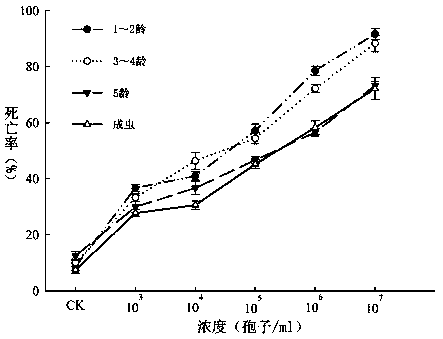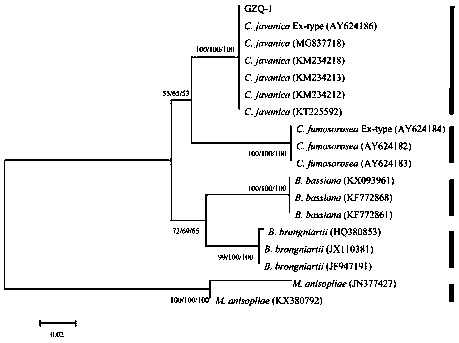Highly pathogenic biocontrol bacteria Cordyceps javanica and application thereof
A highly pathogenic and bio-control bacteria technology, applied in the direction of application, biocide, microorganisms, etc., can solve the problems of high toxicity, loss of biodiversity, excessive pesticide residues, etc., to achieve strong infection and insecticidal effect, strong application potential effect
- Summary
- Abstract
- Description
- Claims
- Application Information
AI Technical Summary
Problems solved by technology
Method used
Image
Examples
Embodiment 1
[0028] Example 1 Isolation and Identification of Cordyceps Javanese Strain GZQ-1
[0029] 1. Source of materials
[0030] (1) Sample: Cordyceps javanica was preserved by the Biological Control Engineering Research Center of the Ministry of Education, South China Agricultural University. The preserved sample of this strain was purified by single cell isolation.
[0031] (2) Potato Dextrose Agar Medium (PDA): 200g peeled potatoes, cut into small pieces, add 1L of water, boil for 20min, filter with gauze: add 20g of glucose while hot, 18-20g of agar, stir to dissolve and mix, set Fill it into an Erlenmeyer flask and sterilize it in an autoclave (121°C, 30min) for 30min.
[0032] (3) Aseptic operating conditions: All utensils and utensils must be sterilized in a pressure cooker (121°C, 30min), and operations such as inoculation are performed in an ultra-clean workbench.
[0033] (4) Culture conditions: culture in a 25°C light (12L:12D) incubator, transfer to a PDA slope after th...
Embodiment 2
[0057] Example 2 Determination of the pathogenicity of Cordyceps javanica GZQ-1 strain to different ages of citrus psyllids
[0058] 1. Bioassay is one of the effective means to detect the lethality and lethality rate of entomogenic fungi to target pests, and can provide an important reference for comprehensive evaluation of the biological control potential of entomogenic fungi. In this study, the pathogenicity of Cordyceps javanica GZQ-1 strain to different ages of citrus psyllids was determined, in order to screen out the optimal age and concentration for its lethality to citrus psyllids.
[0059] 2. Insects and host plants for testing: citrus psyllids. Adults of citrus psyllids were raised in the net room of the Biological Control Engineering Research Center of the Ministry of Education, and inoculated on clean and healthy Jiulixiang. Each plant of Jiulixiang was inserted with about 20 pairs of adults. A net made of PVC film was used to cover each pot of Murata japonica, an...
Embodiment 3
[0082] Embodiment 3 Java Cordyceps GZQ-1 bacterial strain is to citrus psyllid adult field control
[0083] 1 × 10 with Cordyceps javanica GZQ-1 under field conditions 7 Spore / ml spore suspension was used to treat adult citrus psyllids, and Cordyceps fumosorosea strain IF010 and Metarhi ziumanisopliae strain CNGD7 were used as controls.
[0084] For its 13d cumulative survival rate, see image 3 , as the concentration of Cordyceps javanica spores increased, the lethality rate increased, and after 7 days of infection, the infection rate of Cordyceps javanica strain GZQ-1 was significantly higher than that of Cordyceps fumigatus strain IF010 and Metarhizium anisopliae strain CNGD7 (P <0.05).
PUM
 Login to View More
Login to View More Abstract
Description
Claims
Application Information
 Login to View More
Login to View More - R&D
- Intellectual Property
- Life Sciences
- Materials
- Tech Scout
- Unparalleled Data Quality
- Higher Quality Content
- 60% Fewer Hallucinations
Browse by: Latest US Patents, China's latest patents, Technical Efficacy Thesaurus, Application Domain, Technology Topic, Popular Technical Reports.
© 2025 PatSnap. All rights reserved.Legal|Privacy policy|Modern Slavery Act Transparency Statement|Sitemap|About US| Contact US: help@patsnap.com



